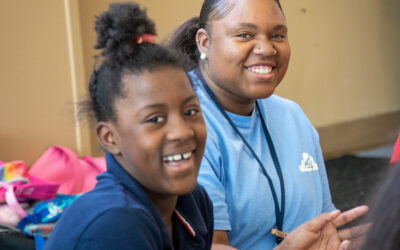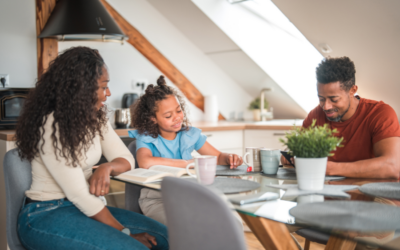As we embark on another exciting academic year, it’s crucial to ensure our students have a smooth and successful transition back to school. The first few weeks of a new school year can be both exhilarating and challenging for students as they navigate new classrooms, routines, and reunite with peers. As another summer comes to an end and students head back to class, fostering a positive and supportive environment can make all the difference to help students reacclimate.
Let’s take a closer look at ways to start students off on the right foot using simple, yet intentional SEL practices.
Cultivate a Welcoming Environment
A warm and inviting classroom environment sets the tone for a positive learning experience. Consider decorating the space with inspiring role models and inclusive messages, displaying student artwork, and incorporating elements that reflect the diverse cultures and backgrounds of your students. When students see their own identities and cultures represented, they will feel valued and acknowledged, thus enhancing their sense of belonging in the classroom. Displays should be designed to be visually stimulating without becoming overwhelming or distracting. As a rule of thumb, 20 to 50 percent of the available wall space should be kept clear to help students stayed focused.
Icebreakers and Community-Building Activities
As students make their initial return, it’s vital to establish a sense of community within the classroom. Icebreaker activities can be an excellent way for students to learn more about each other, fostering connections and breaking down social barriers. Consider incorporating “get-to-know-you” games, team-building exercises, and group discussions that encourage students to share their interests, hobbies, and aspirations. Such activities not only help students feel more comfortable with their peers, but also contribute to a positive and supportive classroom dynamic.
Give these games a try to help students learn more about each other…
Two Truths and A Fib
Try this fun get-to-know-game to help students learn more about each other and improve self-awareness skills.
Common Ground
In this active and engaging game, students will learn more about what they might have in common with their peers.
“Children learn best when content is relevant and relatable, and when they can connect new learning with old concepts. Finding the stickiness between them to make those connections can be challenging, but when you make it a game, it’s easy! Games strengthen problem-solving and social skills, and students enjoy them because they get to have FUN!”
Establish Clear Expectations
Setting clear expectations from the outset helps students understand what is expected of them and promotes a sense of structure. Create classroom rules together with your students, allowing them to take ownership of the guidelines they will follow throughout the year. Encourage open discussions about the values and behaviors that are essential for maintaining a respectful and supportive learning environment. This collaborative approach fosters a sense of responsibility and accountability among students.

Encourage Positive Communication
Promote a culture of kindness and respect within the classroom by encouraging positive communication among students. Teach active listening skills, empathy, and conflict resolution techniques. Establish regular class meetings where students can discuss their thoughts and concerns constructively—strengthening their social bonds and promoting openness.
Create a Consistent Schedule and Routine
A new school year can evoke lots of emotions in our students and even adults! Surprises and new ways of doing things can sometimes bring about big emotions in our students which might cause disruptions in the classroom.
One way to help your students feel more in control and aware of what this new environment will be like for them is to provide a schedule that is consistent. Having a routine in place helps students to know what to expect. Depending on your age group, display the daily schedule somewhere students can see and reference throughout their time with you, and review the schedule at the beginning of their time with you to set expectations and get them familiar with the day’s activities.
Addressing Anxiety and Emotions
The start of a new school year can trigger feelings of anxiety and nervousness in some students. It is essential to create a safe space where students can express their emotions and concerns openly. Encourage them to share what they’re feeling and remind them that it’s okay to experience a range of emotions during this time. Introduce mindfulness and relaxation techniques, such as deep breathing exercises or brief meditation sessions, to help students calm themselves if they feel overwhelmed. Try the Skill Builder Control Check to help students respond appropriately to their emotions, versus just reacting on impulse. By incorporating such practices into daily routines, you can empower students to manage their emotions effectively.
Quick Tips to Support Students
- A space with soft pillows, books, fidget toys, or bean bags can offer respite when students are feeling overwhelmed
- Give students the opportunity to hear you talk about your own feelings and emotions—fostering a safe space for them to share their own
- Teach students a few tips to help them calm themselves and manage the various emotions they might be feeling
- Stock a small bookshelf with a few books that describe emotions or have stories with SEL-focused subjects
Be Intentional About Building Relationships
There’s a lot to get done with your students on any given day, and sometimes it doesn’t feel like there’s ever enough time in the day! A crucial part of the day that sometimes gets overlooked is building intentional time to build relationships with your students.
Building relationships with each of your students enables you to:
- Understand more about them (their background, family, stressors, home situation, etc.) instead of making assumptions.
- Incorporate their interests into their work to make it more relatable and engaging.
- Step into their shoes and see things from their perspective.
When adults are able to show empathy towards students, they feel accepted and understood—which opens the door for connection and stronger relationships. Strong relationships don’t happen overnight or even in the first week of school, but you can set the tone and work on building those relationships starting day one.

As we prepare for a successful new school year, the incorporation of social-emotional learning tools and techniques is an invaluable asset. As adults that work with children day in and day out, we hold the power to equip our youngsters with skills that stretch far beyond the classroom walls. By fostering self-awareness and empathy, we empower them to navigate challenges, build strong relationships, and thrive in an ever-changing world. By embracing open communication and active listening, we create a safe environment where their thoughts and feelings are valued.
Ultimately, as we guide them through this socially and emotionally-focused approach to education, we set them on a trajectory toward not only academic achievement but also lifelong emotional intelligence and well-being.















